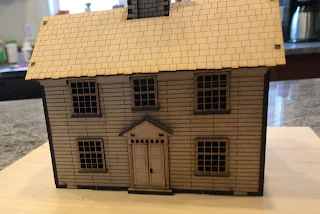Here are some of my Fife and Drum miniatures Grenadiers and Light Infantry by a very nice colonial home by Impudent Mortal. Funny sounding name but great buildings. These houses are of a "heroic" size , so may be slightly larger then other structures in your collections. But they are outstanding.
Unfortunately, visiting their website I found out the owner has passed away and the business is temporarily closed. I am most sorry for his family at this time.
Here is the Captain William Smith House from Things From the Basement. It is a great house and I am looking forward to more in the future. It is a little smaller then the other building as you can see.
What you do on your table is up to you. You look things over and pick what works or looks best to you. I like both very much. Like in real life no two buildings are exactly the same. In my neighborhood the same model homes are slightly different in size due to the builder wanting to save money! My personal opinion? I will field them in the same table. Possibly Not next to each other but I will use them together in the same village.





























